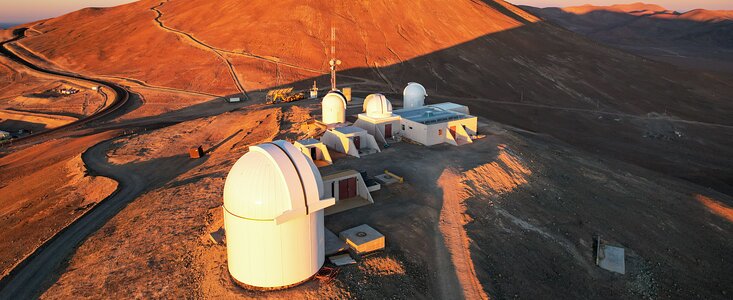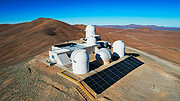Announcement
Rolf Chini Cerro Murphy Observatory inaugurated
28 November 2023
Today, in a celebration at Cerro Murphy in the Chilean Atacama Desert, the Nicolaus Copernicus Astronomical Center of the Polish Academy of Sciences (CAMK), along with the European Southern Observatory (ESO) and other entities, inaugurated the renewed Rolf Chini Cerro Murphy Observatory. Hosted within ESO’s Paranal Observatory, the Observatory has undergone a major rebuild since 2020 and is ready to begin scientific observations again, marking a new chapter in its history.
The Rolf Chini Cerro Murphy Observatory inauguration celebrates the beginning of scientific operations for three new optical telescopes, which will join existing facilities to explore how fast the Universe is expanding.
The Observatory is dedicated to the Araucaria Project, a collaboration between astronomers from Chile, the USA and Europe, focused on improving the calibration of the extragalactic distance scale, a combination of methods by which astronomers measure the distance of objects throughout the Universe. The data gathered at the Observatory will be important for determining precisely the expansion rate of the Universe.
Located in the high and dry Atacama Desert, the observing conditions are among the best in the world. As well as sharing pristine skies with other ESO telescopes — ESO’s Extremely Large Telescope (ELT) is under construction on the neighbouring Cerro Armazones, and Cerro Paranal, where ESO’s Very Large Telescope (VLT) is located, is just 20 kilometres away — the separate facilities will share resources such as fibre optic cables for internet and access roads.
In addition to the renewed scientific capability of the Observatory, the inauguration also marks a new era in its operation. In 2020, leadership was transferred from the Ruhr University Bochum (RUB) and the Catholic University of the North (UCN), who had jointly run it since 2005, to CAMK. Formerly called the Cerro Armazones Observatory, the new name honours Rolf Chini, a professor at RUB who is credited with the creation and development of the observatory, and Cerro Murphy, the hill it resides on.
The new optical telescopes include the 1.5-metre telescope Janusz Kałużny, for imaging and high resolution spectroscopy, as well as the 0.8-metre telescope Zbigniew "Zibi" Kołaczkowski and the 0.6-metre telescope Wojtek Krzemiński, both for imaging. In addition, a new 2.5-metre telescope, the largest Polish telescope to date, will be added to the Observatory, with the start of operations planned for 2025. From the Observatory’s previous operations are the 0.8-metre InfraRed Imaging System (IRIS), an infrared imager, and the 30-centimetre BMK10k, a robotic, wide-field camera operated by the Leibniz-Institute for Astrophysics in Potsdam.
To follow along with the celebrations, watch the inauguration on YouTube.
Links
Contacts
Bárbara Ferreira
ESO Media Manager
Garching bei München, Germany
Tel: +49 89 3200 6670
Email: press@eso.org
About the Announcement
| Id: | ann23020 |
Our use of Cookies
We use cookies that are essential for accessing our websites and using our services. We also use cookies to analyse, measure and improve our websites’ performance, to enable content sharing via social media and to display media content hosted on third-party platforms.
ESO Cookies Policy
The European Organisation for Astronomical Research in the Southern Hemisphere (ESO) is the pre-eminent intergovernmental science and technology organisation in astronomy. It carries out an ambitious programme focused on the design, construction and operation of powerful ground-based observing facilities for astronomy.
This Cookies Policy is intended to provide clarity by outlining the cookies used on the ESO public websites, their functions, the options you have for controlling them, and the ways you can contact us for additional details.
What are cookies?
Cookies are small pieces of data stored on your device by websites you visit. They serve various purposes, such as remembering login credentials and preferences and enhance your browsing experience.
Categories of cookies we use
Essential cookies (always active): These cookies are strictly necessary for the proper functioning of our website. Without these cookies, the website cannot operate correctly, and certain services, such as logging in or accessing secure areas, may not be available; because they are essential for the website’s operation, they cannot be disabled.
Functional Cookies: These cookies enhance your browsing experience by enabling additional features and personalization, such as remembering your preferences and settings. While not strictly necessary for the website to function, they improve usability and convenience; these cookies are only placed if you provide your consent.
Analytics cookies: These cookies collect information about how visitors interact with our website, such as which pages are visited most often and how users navigate the site. This data helps us improve website performance, optimize content, and enhance the user experience; these cookies are only placed if you provide your consent. We use the following analytics cookies.
Matomo Cookies:
This website uses Matomo (formerly Piwik), an open source software which enables the statistical analysis of website visits. Matomo uses cookies (text files) which are saved on your computer and which allow us to analyze how you use our website. The website user information generated by the cookies will only be saved on the servers of our IT Department. We use this information to analyze www.eso.org visits and to prepare reports on website activities. These data will not be disclosed to third parties.
On behalf of ESO, Matomo will use this information for the purpose of evaluating your use of the website, compiling reports on website activity and providing other services relating to website activity and internet usage.
Matomo cookies settings:
Additional Third-party cookies on ESO websites: some of our pages display content from external providers, e.g. YouTube.
Such third-party services are outside of ESO control and may, at any time, change their terms of service, use of cookies, etc.
YouTube: Some videos on the ESO website are embedded from ESO’s official YouTube channel. We have enabled YouTube’s privacy-enhanced mode, meaning that no cookies are set unless the user actively clicks on the video to play it. Additionally, in this mode, YouTube does not store any personally identifiable cookie data for embedded video playbacks. For more details, please refer to YouTube’s embedding videos information page.
Cookies can also be classified based on the following elements.
Regarding the domain, there are:
- First-party cookies, set by the website you are currently visiting. They are stored by the same domain that you are browsing and are used to enhance your experience on that site;
- Third-party cookies, set by a domain other than the one you are currently visiting.
As for their duration, cookies can be:
- Browser-session cookies, which are deleted when the user closes the browser;
- Stored cookies, which stay on the user's device for a predetermined period of time.
How to manage cookies
Cookie settings: You can modify your cookie choices for the ESO webpages at any time by clicking on the link Cookie settings at the bottom of any page.
In your browser: If you wish to delete cookies or instruct your browser to delete or block cookies by default, please visit the help pages of your browser:
Please be aware that if you delete or decline cookies, certain functionalities of our website may be not be available and your browsing experience may be affected.
You can set most browsers to prevent any cookies being placed on your device, but you may then have to manually adjust some preferences every time you visit a site/page. And some services and functionalities may not work properly at all (e.g. profile logging-in, shop check out).
Updates to the ESO Cookies Policy
The ESO Cookies Policy may be subject to future updates, which will be made available on this page.
Additional information
For any queries related to cookies, please contact: pdprATesoDOTorg.
As ESO public webpages are managed by our Department of Communication, your questions will be dealt with the support of the said Department.


